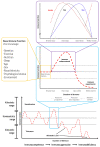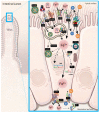A Bioinformatics-Assisted Review on Iron Metabolism and Immune System to Identify Potential Biomarkers of Exercise Stress-Induced Immunosuppression
- PMID: 35327526
- PMCID: PMC8945881
- DOI: 10.3390/biomedicines10030724
A Bioinformatics-Assisted Review on Iron Metabolism and Immune System to Identify Potential Biomarkers of Exercise Stress-Induced Immunosuppression
Abstract
The immune function is closely related to iron (Fe) homeostasis and allostasis. The aim of this bioinformatics-assisted review was twofold; (i) to update the current knowledge of Fe metabolism and its relationship to the immune system, and (ii) to perform a prediction analysis of regulatory network hubs that might serve as potential biomarkers during stress-induced immunosuppression. Several literature and bioinformatics databases/repositories were utilized to review Fe metabolism and complement the molecular description of prioritized proteins. The Search Tool for the Retrieval of Interacting Genes (STRING) was used to build a protein-protein interactions network for subsequent network topology analysis. Importantly, Fe is a sensitive double-edged sword where two extremes of its nutritional status may have harmful effects on innate and adaptive immunity. We identified clearly connected important hubs that belong to two clusters: (i) presentation of peptide antigens to the immune system with the involvement of redox reactions of Fe, heme, and Fe trafficking/transport; and (ii) ubiquitination, endocytosis, and degradation processes of proteins related to Fe metabolism in immune cells (e.g., macrophages). The identified potential biomarkers were in agreement with the current experimental evidence, are included in several immunological/biomarkers databases, and/or are emerging genetic markers for different stressful conditions. Although further validation is warranted, this hybrid method (human-machine collaboration) to extract meaningful biological applications using available data in literature and bioinformatics tools should be highlighted.
Keywords: allostasis; exercise; ferritins; hemeproteins; immune system; metabolic networks and pathways; physiological stress response; transferrin receptor.
Conflict of interest statement
D.A.B. serves as a Science Product Manager for a company producing dietary supplements in Europe (MTX Corporation®) that sells iron-based products and has acted as scientific consultant for MET-Rx and Healthy Sports in Colombia. D.A.F. has been previously supported by grants from MinCiencias but not related to iron. J.R.S. has conducted industry-sponsored research on nutraceuticals over the past 25 years. J.R.S has also received financial support for presenting on the science of various nutraceuticals at industry-sponsored scientific conferences. E.S.R. has conducted industry-sponsored research and received financial support for presenting on nutrients at industry-sponsored scientific conferences. R.B.K. has conducted a number of industry-sponsored studies on sports-nutrition-related nutrients, has served as a paid consultant and has received honorariums to speak at conferences by industry. Additionally, R.B.K. serves as chair of the “
Figures






Similar articles
-
Considerations on the mechanism of action of artemisinin antimalarials: part 1--the 'carbon radical' and 'heme' hypotheses.Infect Disord Drug Targets. 2013 Aug;13(4):217-77. doi: 10.2174/1871526513666131129155708. Infect Disord Drug Targets. 2013. PMID: 24304352 Review.
-
Planning Implications Related to Sterilization-Sensitive Science Investigations Associated with Mars Sample Return (MSR).Astrobiology. 2022 Jun;22(S1):S112-S164. doi: 10.1089/AST.2021.0113. Epub 2022 May 19. Astrobiology. 2022. PMID: 34904892
-
Iron and Its Role in Cancer Defense: A Double-Edged Sword.Met Ions Life Sci. 2018 Feb 5;18:/books/9783110470734/9783110470734-021/9783110470734-021.xml. doi: 10.1515/9783110470734-021. Met Ions Life Sci. 2018. PMID: 29394034 Review.
-
The human innate immune protein calprotectin induces iron starvation responses in Pseudomonas aeruginosa.J Biol Chem. 2019 Mar 8;294(10):3549-3562. doi: 10.1074/jbc.RA118.006819. Epub 2019 Jan 8. J Biol Chem. 2019. PMID: 30622135 Free PMC article.
-
The plasma membrane proteome of maize roots grown under low and high iron conditions.J Proteomics. 2013 Oct 8;91:605-18. doi: 10.1016/j.jprot.2013.01.006. Epub 2013 Jan 24. J Proteomics. 2013. PMID: 23353019
Cited by
-
Discovering Thematically Coherent Biomedical Documents Using Contextualized Bidirectional Encoder Representations from Transformers-Based Clustering.Int J Environ Res Public Health. 2022 May 12;19(10):5893. doi: 10.3390/ijerph19105893. Int J Environ Res Public Health. 2022. PMID: 35627429 Free PMC article.
-
Adaptogens on Depression-Related Outcomes: A Systematic Integrative Review and Rationale of Synergism with Physical Activity.Int J Environ Res Public Health. 2023 Mar 28;20(7):5298. doi: 10.3390/ijerph20075298. Int J Environ Res Public Health. 2023. PMID: 37047914 Free PMC article.
-
Evaluation of protein's interaction and the regulatory network of some drought-responsive genes in Canola under drought and re-watering conditions.Physiol Mol Biol Plants. 2023 Aug;29(8):1085-1102. doi: 10.1007/s12298-023-01345-1. Epub 2023 Sep 1. Physiol Mol Biol Plants. 2023. PMID: 37829706 Free PMC article.
-
Genes and Pathways Involved in the Progression of Malignant Pleural Mesothelioma: A Meta-analysis of Genome-Wide Expression Studies.Biochem Genet. 2024 Feb;62(1):352-370. doi: 10.1007/s10528-023-10426-5. Epub 2023 Jun 22. Biochem Genet. 2024. PMID: 37347449
-
The 4Rs Framework of Sports Nutrition: An Update with Recommendations to Evaluate Allostatic Load in Athletes.Life (Basel). 2025 May 27;15(6):867. doi: 10.3390/life15060867. Life (Basel). 2025. PMID: 40566521 Free PMC article. Review.
References
-
- Campbell P., Parish H., Smith A., Vella F., Stirling J. Oxford Dictionary of Biochemistry and Molecular Biology. Oxford University Press; Oxford, UK: 2006.
Publication types
LinkOut - more resources
Full Text Sources

